On fascist violence, racism and people’s struggles in the U.S. (Part 1)
This is Part 1 of a series of commentaries by PRISM editors and Art Belisario on the ongoing events and trends in the U.S. around the issue of racist violence by state forces and the people’s massive protest actions in the wake of the Covid-19 pandemic, lockdowns, and socio-economic crisis.
COMMENTARIES:
ON FASCIST VIOLENCE, RACISM AND PEOPLE’S STRUGGLES IN THE U.S. (Part 1)
By ART BELISARIO and PRISM EDITORS
5 June 2020
The thunder of daily protests, now spreading across an estimated 200 cities in all 50 states of the United States and elsewhere, is a mostly spontaneous but justified response of the people against the fascist brutality by the militarized forces of U.S. police departments.
The immediate trigger for the protest was the brazen killing of George Floyd by Minneapolis police officers on May 25. Caught on video, the arrest showed a police officer employing the now infamous “knee-on-neck” restraint on the defenseless Floyd for nearly nine minutes, choking the African-American to death. Three other police officers stood on alert against the outraged onlookers.
As the news of the police killing spread, the people’s reaction across the US was nearly unanimous and instantaneous. Outraged, most people joined peaceful street rallies to express their protest. But the authorities responded violently. In many cases, riot police shot teargas and rubber bullets into the agitated crowds and arrested frontliners, triggering more militant forms of resistance.
Defending themselves, protestors began blocking key roads and pelting police ranks with rocks and bricks. Others vented their ire spontaneously on police stations and squad cars, many of which were overrun, torched, or paint-sprayed. In some cities, the people’s outrage overflowed into street riots. Shops and offices were looted or burned—often provoked and urged by agent-provocateurs in civilian clothes deployed by the FBI and local police to infiltrate protestors’ ranks.
Federal and some state authorities, citing incidents of urban mayhem in some cities such as New York and Chicago which were blown out of proportion by reactionary media, condemned the protests wholesale as “riots,” imposed night curfews. further escalated police action, and called for National Guard troop reinforcements. US President Trump himself has openly threatened martial law and moved to legally designate “antifa” (anti-fascist ) protestors as “terrorists”.
But the people are continuing with mass protests. They are defying night curfews and threats of mass arrest, and learning to fight back more effectively.
More triggering factors
The polarization of U.S. society has been accelerating under Trump’s presidency, fuelled by the basic contradictions of monopoly capitalism, by the socio-economic impacts of the Great Recession of 2008-09 and its subsequent aftershocks, including heightened public awareness of extreme social inequalities, the shrinking middle class and the growing precariat, and by failing military adventures overseas.
By end-2019, many astute observers were already warning of financial bubbles about to burst and other persistent factors for economic downturns looming on the horizon. U.S.-China rivalries were heating up. The start of 2020—a U.S. presidential election year—also saw intense political in-fighting among its ruling-class factions.
Then came the Covid-19 pandemic and its direct adverse impact on the people’s health and healthcare systems, with millions falling ill, one in five severe enough to need hospitalization, and nearly 400,000 Covid-related deaths worldwide; the U.S. suffered 30% of the global death toll. The pandemic also triggered a fight-flee-or-freeze response by public authorities in all countries.
Many governments, unsure on how to “fight” or “flee” the new and barely-known viral threat, chose to emphasize the “freeze” option by imposing various lockdown modes on entire populations. Within a few weeks, whole economic and financial sectors went into free fall and drastic slumps as supply-chain breakdowns and financial panic reverberated around the globe,
Massive unemployment and business uncertainty became inevitable results. In the US alone, 40 million have lost their jobs in the past 10 weeks. Businesses are failing at historically unprecedented rates. The US economy is collapsing at a rate faster than the collapse during the 1930s Great Depression. The Federal Reserve is desperately trying to slow the hemorrhage by printing trillions of dollars to conjure an artificial, jobless growth.
This, other drastic lockdown effects on people’s daily lives, combined with the factional in-fighting, blame game and mishandling of the Covid-19 health crisis among federal and state authorities, served to whip up a “perfect storm.”
Clearly, the US socio-economic and political situation was already super-charged before the Floyd killing on May 25. At the height of the lockdown (earlier in May), in fact, health worker Breonna Taylor was shot dead while asleep at home by Louisville, Kentucky police who had raided the wrong house. In February, Ahmaud Arbery was shot dead by an ex-policeman near Brunswick, Georgia. But these incidents were quickly swept away from the public eye because of the horrendous Covid-19 death toll. As summer approached, however, with lockdown restrictions grudgingly eased, a looming Greater Depression stared the country in the eye. Massive bombs of social unrest were just waiting for someone to trip the wire.
Furthermore, two distinct but intertwined trends added to the explosive mix: the continuing racism against US people of color, and fascist militarism as shown by a long history of police brutality.
Racist violence in the interest of the big bourgeoisie
The struggle of the black people in America against racist or national oppression is a long and complex historic process. This PRISM commentary can only deal with the most immediate aspects relevant in the Floyd killing: namely, that the African-American people and likewise migrant peoples in the US are confronted with a systematic and state-sanctioned (and therefore strong and persistent) racist bias and hostility against people of color.
After legal slavery was abolished in the 1860s, US history continued to show persistent forms of systematic state violence against black people—either directly by the US government or by White-supremacist groups coddled by the government.
The civil-rights and radical movements of the 1960s and early 1970s dampened some of the worst forms of racist violence, such as public lynchings and police-enforced segregation. But police brutality targetting poor black communities persists until now because, wielded by the big bourgeoisie, it remains an effective weapon of national oppression against blacks and other peoples of color or migrant status, side by side with class oppression against all toiling masses. One type of oppression intensifies the other. In various ways, state violence along racial lines keeps the toiling masses stratified and divided according to a pecking order. Reactionaries use both blatantly racist and ostensibly “anti-racist” cards to misdirect the focus of the oppressed classes away from their common class enemy.
The world is now into the third decade of the 21st century, yet US statistics on “stop-and-frisk” and “drug war” operations, criminal cases, prison demographics, and police killings continue to show a deep-rooted trend of law-enforcement bias against black people.
Long list of African-American victims of police killings. George Floyd’s murder at the hands of a Minneapolis police officer is obviously not the first time, and neither will it be the last. The case of Eric Garner, another African-American victim of a NYC police killing in 2014, is eerily similar. In both cases, the victims were accosted by police on the suspicion of minor offenses. In both cases, the victims were outnumbered by the police, were unarmed, and did not pose any discernible threats. Finally, both victims were choked to death on video and uttered exactly the same words before dying: “I can’t breathe.”
Before George Floyd, Breonna Taylor and Ahmaud Arbery (all killed in 2020), well-documented African-American victims of unjustified U.S. police killings in recent years include:
- Atatiana Jefferson—shot dead by a police officer in her home in Forth Worth, Texas (October 2019)
- Stephon Clark—shot dead by two police officers (March 2018, in Sacramento, California)
- Terence Crutcher—shot dead by a police officer (September 2016, in Tulsa, Oklahoma)
- Keith Lamont Scott—shot dead by a police officer (September 2016 in Charlotte, North Carolina)
- Alton Sterling—shot dead at close range by two police officers (July 2016 in Baton Rouge, Louisiana)
- Philando Castile—shot dead by a police officer (July 2016 in St. Paul, Minnesota)
- Jamar Clark—shot dead by two police officers (November 2015 in Minneapolis, Minnesota)
- Sandra Bland—found hanged in a jail cell (July 2015 in Waller County, Texas)
- Walter Scott—shot dead by a police officer (April 2015 in Charleston, South Carolina)
- Freddie Gray—died while in police custody (April 2015 in Baltimore, Maryland)
- Tamir Rice—shot dead by a police officer (November 2014 in Cleveland, Ohio)
- Laquan McDonald—shot dead by a police officer (October 2014 in Chicago, Illinois)
- Michael Brown—shot dead by a police officer (August 2014 in Ferguson, Missouri)
- Eric Garner—killed by means of a chokehold by a police officer (July 2014 in New York City)
- Jonathan Ferrell—shot dead by a police officer (September 2013 in Charlotte, North Carolina)
- Clinton Allen—shot dead by a police officer (March 2013 in Dallas, Texas)
- Trayvon Martin—shot dead by a neighborhood watch coordinator (February 2012 in Sanford, Florida)
- Oscar Grant III—shot dead by a BART police officer (New Year’s Day 2009 in Oakland, California)
- Arthur McDuffie—shot dead by several police officers (May 1980 in Miami-Dade, Florida)
As we post this piece, more innocent people have been shot and killed in the aftermath of the Floyd killing and ensuing protests. These include Tony McDade (a black transgender man, by the Tallahassee, Florida police) and David McAtee (a black man, by Louisville, Kentucky police).
Militarized police as tool of the big bourgeoisie
While racism has long been a distinct factor in US police killings, it does not explain everything. Another reinforcing factor is the steady militarization of law enforcement especially in recent decades.
Despite a deep US tradition of separating civilian police functions from military functions and barring the armed forces from enforcing domestic policies (as enshrined in federal laws such as the Posse Comitatus Act), each state can call on National Guard units to assist in law enforcement. This was long before the 1990s. After the Cold War ended, however, US imperialism used its anti-terrorist and anti-drug wars as new reasons to keep militarism at a high pitch—not only for its aggressive wars and military presence abroad but also for its domestic law enforcement and homeland security programs.
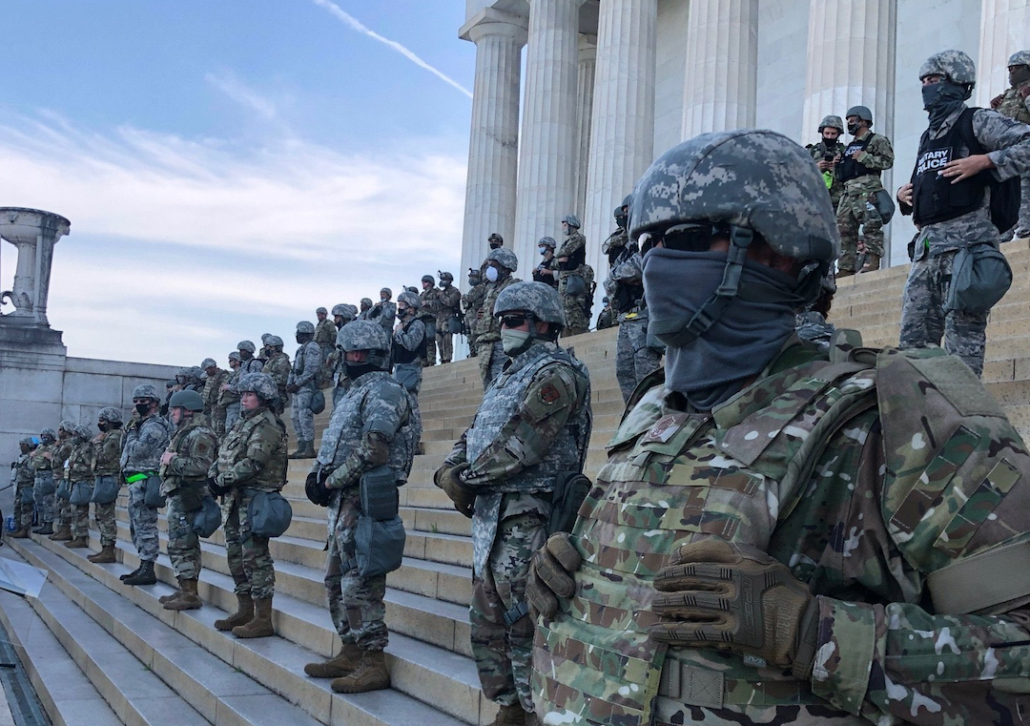
Main elements of militarization. Police militarization means that civilian law enforcement agencies increasingly adapt the military approach in terms of doctrine, mindset, organizational culture, structure and rules, operational tactics and equipment. The military model, centered on waging wars and crushing hostile forces in armed conflict, is in contrast to the traditional police model of keeping peace and order among the civilian population. Yet, especially under modern imperialism and intensifying social conflicts, the dividing line has become increasingly blurred.
One study found that use of paramilitary-style teams by US law enforcement increased by more than 1,400 percent since 1980. The most obvious signs of a militarized police force is in equipment: high-powered assault weapons, military attire (e.g. personal armor and riot gear), armored vehicles and aircraft (e.g. police choppers and aerial drones).
Heavily armed SWAT (“special weapons and tactics”) teams and similar police units, in their advanced combat training and command structure, follow the Special Forces model. A large percentage of local police departments now receive training from active-duty Navy SEALs and Army Ranger units. Synergies between police trainees and military trainors developed during training continue in post-training.
Dumping ground of military-industrial complex. The militarization of police forces, first of all, is driven by the economics of the fast-expanding US military-industrial complex. Since the 1990s, the Department of Defense’s “1033 program” has supplied local law enforcement agencies with military-grade equipment—which would otherwise be destroyed because it is no longer deemed useful to US armed forces. Through such a program, excess military equipment enjoy a second life in the hands of wannabe-military police forces. Grants by the Departments of Justice and Homeland Security also provide funds to law-enforcement units to buy arms from private manufacturers.
The 1033 program expanded during Trump’s presidency. As of July 2017, over 8,000 law enforcement agencies have utilized the said program to access more than USD 6 billion worth of military equipment such as night-vision goggles, machine guns, bayonets, grenade launchers, armored vehicles, military aircraft, field packs, canteens, sleeping bags, and ponchos.
Worsening fascist police brutality vs the people. Once the police forces are militarized, their mission creep picks up speed, towards openly fascist objectives. Formerly used only for major crowd control operations, they are now routinely deployed in communities profiled as “crime-prone” or “riot-prone,” especially neighborhoods of blacks, immigrants, and other people of color. Police abuses against poor people have steadily worsened, and not just in big cities but also in smaller towns.
The number of police killings categorized as “justifiable homicide” is estimated at around 930 per year, according to Bureau of Justice statistics released in 2015. These do not include police killings outside the “justifiable homicide” category. The newspaper The Guardian, which tracked US police killings, counted 1,146 deaths in 2015 and 1,093 deaths in 2016. (Wikipedia lists annual figures of US police killings regardless of reason, justifiability or method, from 2009 to 2020. See: https://en.wikipedia.org/wiki/Lists_of_killings_by_law_enforcement_officers_in_the_United_States )
Honed by years of practice in waging the “war on drugs,” SWAT teams are now regularly used for routine operations such as serving warrants. In “no-knock” raids, they break into residential buildings with military precision, often using percussion grenades and battering rams in addition to regular firearms. Such raids often result in unwarranted damage to property and excessive violence, including killings especially when the civilians resist.
In the face of a defiant community or crowd, militarized SWAT teams act like a wartime occupying force, fingers ready on the trigger, always suspicious of any “wrong move” and always alert for attacks from any direction, They employ heavy-handed police tactics, including no-knock raids, close-quarters combat, lethal chokeholds, and snipers aiming at suspected “threats”. As a result, they reinforce the already preexisting and deep sources of mistrust and hostility between government and citizenry.
For similar objectives, but from the reverse view, many enclaves of the rich and famous (e.g. such as the Hamptons in New York) now boast of their own counter-terrorism police teams, in order to protect high-society cultural and social events and the VIP’s attending them.
Veteran US activists of the 1960s-1970s civil-rights, antiwar and radical movements are not really surprised that militarized police forces and operations have ballooned since then. Decades of social research have shown that such operations have served to maintain race-based and class-based oppressive social structures. Police militarization is a means by which the big-bourgeois state exercises political-military, and in some respects even cultural-psychological, control over an increasingly rebellious people. # Forthcoming: Part 2
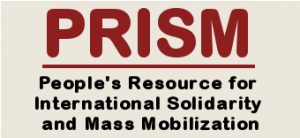
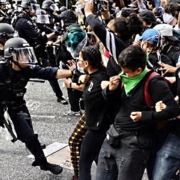
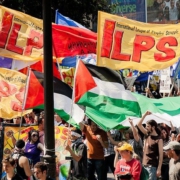
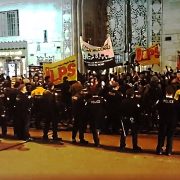
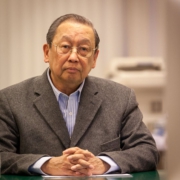
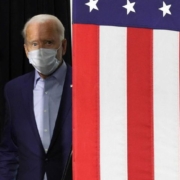


Leave a Reply
Want to join the discussion?Feel free to contribute!